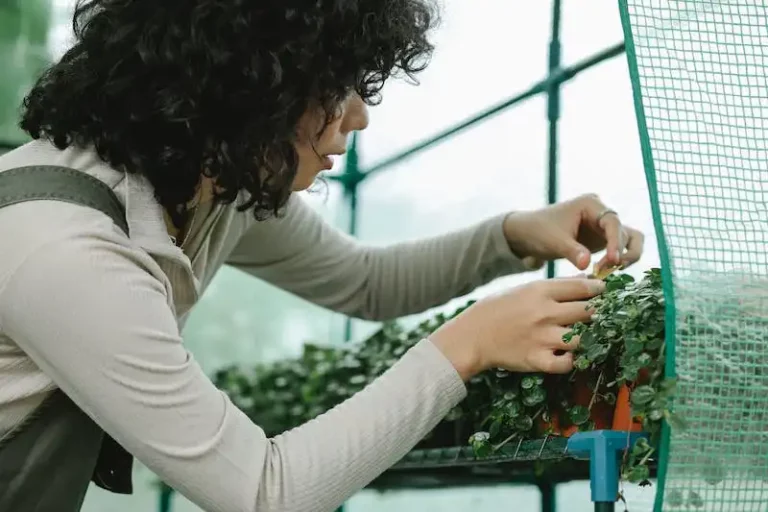Lemon verbena, or Aloysia citrodora, is a perennial herb that is highly valued for its distinct lemon scent and numerous uses in cooking and herbal therapy. Growing lemon verbena is a rewarding experience, whether you have a large garden or just a few pots. Here, we will discuss the different ways to grow lemon verbena and provide helpful tips for successful cultivation.
First and foremost, lemon verbena tends to grow best in pots. This is because the plant requires well-drained soil and can be sensitive to frost. By growing lemon verbena in pots, you can easily move the plant indoors or to a sheltered area when cold weather hits. Additionally, potted plants allow you to control the soil conditions and provide the necessary drainage for optimal growth.
When choosing a pot for your lemon verbena, opt for one that is at least 12 inches in diameter and filled with a good quality potting mix. Ensure that the pot has drainage holes at the bottom to prevent waterlogging, as lemon verbena prefers slightly dry conditions. You may also consider adding some organic matter, such as compost or aged manure, to improve the soil structure.
While lemon verbena can be grown from seeds, it is more common to propagate the plant from a cutting. If you already have a lemon verbena plant, take a stem cutting that is about 6-8 inches in length. Remove the lower leaves from the cutting, leaving only a few at the top. Dip the cut end in rooting hormone and plant it in a pot filled with moist potting mix. Place the pot in a warm area with indirect sunlight, and moisten the soil as needed. Over time, the cutting will develop roots and grow into a new lemon verbena plant.
Whether you choose to grow lemon verbena indoors or outdoors, ensure that the plant receives plenty of sunlight. Lemon verbena thrives in full sun and should ideally get at least 6-8 hours of direct sunlight each day. If you live in an area with harsh summers, providing some shade during the hottest part of the day can help prevent scorching of the leaves.
When it comes to watering lemon verbena, strike a balance. While the plant likes slightly dry conditions, it should not be completely deprived of water. Water the plant thoroughly and deeply, allowing the soil to dry out slightly between waterings. Be careful not to overwater, as excessive moisture can lead to root rot and other diseases.
After your lemon verbena plant has been established, you can start harvesting its leaves. Leaf harvesting can be done throughout the growing season, but it is best to avoid removing all the leaves at once. Instead, pluck a few leaves from each stem, taking care not to damage the whole plant. Lemon verbena leaves can be used fresh or dried for various culinary purposes, such as flavoring teas, infusing oils, or adding a zesty taste to desserts.
When it comes to dealing with pests, lemon verbena is generally resistant to many common garden pests. However, whiteflies can sometimes be a problem. If you encounter whiteflies on your lemon verbena, you can try using organic pest control methods or simply wash them off with a gentle spray of water.
In conclusion, growing lemon verbena is a delightful endeavor that can be enjoyed by both experienced and novice gardeners. Its delicious lemon scent, versatile uses, and easy propagation make it a valuable addition to any garden or herb collection. Whether you grow lemon verbena in pots or in your garden, follow these tips and enjoy the fresh and fragrant foliage for years to come.
Lemon Verbena
Lemon Verbena is a perennial shrub that is well-known for its fragrant lemon scent. It is native to South America and is valued for its culinary and medicinal uses. Lemon Verbena has a long history and it can be traced back to ancient tales of sailors and explorers bringing the plant to Europe and other parts of the world.
The leaves of the Lemon Verbena plant are the main source of its fragrance. They are long and narrow, resembling lanceolate leaves. When crushed or rubbed, the leaves release a strong lemon scent that stimulates the senses.
One must be careful when handling Lemon Verbena as its oils can cause skin irritation. However, it is safe for cooking and can be used to add a lemony flavor to various dishes and desserts.
Lemon Verbena is easy to grow and can be planted both outdoors and indoors. It prefers full sunlight and well-drained soil. In terms of temperature, it is best to keep the plant in an environment with temperatures above 40°F (4°C). If temperatures drop below freezing, the plant may not survive and its leaves may drop.
When planting Lemon Verbena, it is important to keep in mind its spreading nature. The shrub can grow up to 5 feet (1.5 meters) in length and may require regular pruning to keep it in check.
If you decide to grow Lemon Verbena indoors, it is better to choose a location near a sunny window or under a grow light. This way, the plant can have access to sufficient sunlight, which is vital for its growth.
Lemon Verbena can also be kept in containers, allowing for more mobility. However, it is important to note that the plant may not reach its full size when kept in a pot.
When it comes to watering, Lemon Verbena prefers to be kept slightly moist. Over-watering can cause the roots to rot and lead to a lifeless plant. On the other hand, under-watering can cause the leaves to wilt and drop.
The best time to harvest Lemon Verbena leaves is during spring or early summer when they are at their peak flavor. The leaves can be used fresh, dried, or frozen for later use. Dried Lemon Verbena leaves can be stored in airtight containers and used in various recipes.
In addition to its culinary uses, Lemon Verbena is also known for its medicinal properties. It is said to aid digestion, relieve anxiety, and help with insomnia.
In conclusion, Lemon Verbena is a versatile plant that can be grown both indoors and outdoors. With its fragrant leaves and various uses, it is a great addition to any garden or kitchen.
Growing Tender Perennial
Lemon verbena is a tender perennial plant that is native to South America. It is a member of the Verbenaceae family. This herb is highly prized for its lemony fragrance and is commonly used in cooking, beverages, and desserts.
In areas where temperatures drop below freezing, lemon verbena can be a victim of frost and freeze. The plant can lose all its leaves and appear lifeless. However, do not be discouraged, as lemon verbena is capable of coming back to life once the warm spring weather arrives.
To protect your lemon verbena plant from frost and freeze, it is best to move it indoors where it can be grown as a potted plant. The plant needs at least 6-8 hours of sunlight per day, so place it near a sunny window or under grow lights. Make sure to bring the plant inside before the first frost hits.
If you decide to keep your lemon verbena plant outdoors, you can use organic mulch to help protect the roots from freezing temperatures. It is also a good idea to plant it in an area with good drainage to prevent waterlogging during winter.
If your lemon verbena plant starts to get leggy or loses its leaves, you can prune it back to encourage new growth. The leaves can also be used for cooking or to make fragrant oils for therapeutic use.
Propagation of lemon verbena is easy and can be done either by stem cuttings or by seed. Cuttings can be taken in late spring or early summer. Simply cut a 4-6 inch stem below a leaf node and remove the lower leaves. Place the cutting in a glass of water or in a well-draining potting mix until roots form.
| Propagation Method | Best Time |
|---|---|
| Stem Cuttings | Late Spring or Early Summer |
| Seed | March or Warm Spring |
Lemon verbena is known to attract whiteflies and other bugs. To keep these pests at bay, regularly inspect your plant for any signs of infestation. You can also use organic insecticides or companion planting to deter pests.
When bringing your lemon verbena plant back outside after winter, gradually introduce it to outdoor conditions. Start by placing it in a shaded area for a few hours a day, and then gradually move it to a sunnier spot. This process will help harden off the plant and prevent sunburn.
In conclusion, growing lemon verbena as a tender perennial can be a rewarding experience. Whether you choose to grow it in containers or in your garden, this herb will provide you with a great source of fragrance, culinary delight, and a touch of green life.
Harvesting
Harvesting lemon verbena leaves is a delightful task for any gardener. The leaves, rich in aromatic oils, can be used in a variety of ways, from adding flavor to desserts and drinks to infusing them with their refreshing scent. Here are some tips on how to harvest your lemon verbena plant.
Lemon verbena is a perennial herb that grows best in warm climates. It doesn’t tolerate frost well, so it should be placed in a location protected from strong winds and cold temperatures. The plant needs to be watered regularly, but its roots are sensitive to over-watering, so good drainage is necessary.
In the summer months, lemon verbena produces a profusion of basal foliage. The leaves can be harvested throughout the growing season, but it’s best to wait until the plant is well-established before harvesting. The foliage has the most flavor when it is still tender and young.
To harvest the leaves, simply use a pair of sharp scissors or pruning shears to cut off the 3-inch basal leaf stems. Make sure to cut just above a leaf node to encourage new growth. It’s important to trim the plant regularly to keep it bushy and to prevent it from becoming leggy.
If you’d like to use the leaves immediately, you can wash them in cool water and pat them dry with a paper towel. You can also store them in a plastic bag in the refrigerator until you’re ready to use them. Another option is to hang the stems upside down in a warm, dry place until they are completely dried. Once dried, you can store the leaves in an airtight container for later use.
Lemon verbena is relatively pest-free, but it can attract aphids and other bugs. If you notice any pests on your plants, simply spray them off with a strong stream of water or introduce beneficial insects to keep them under control.
It’s important to note that lemon verbena may go into dormancy during colder months. If you live in an area with freezing temperatures, you may need to move the plant indoors or cover it with a plastic sheet to protect it from frost.
In summary, harvesting lemon verbena leaves is a simple task that can be enjoyed throughout the growing season. By following the proper techniques, you can ensure a bountiful harvest of this fragrant and versatile herb.

